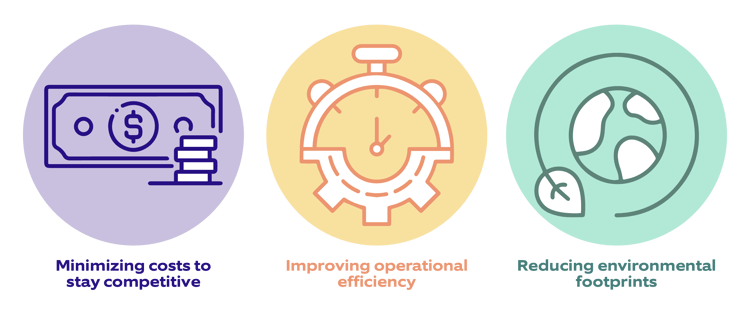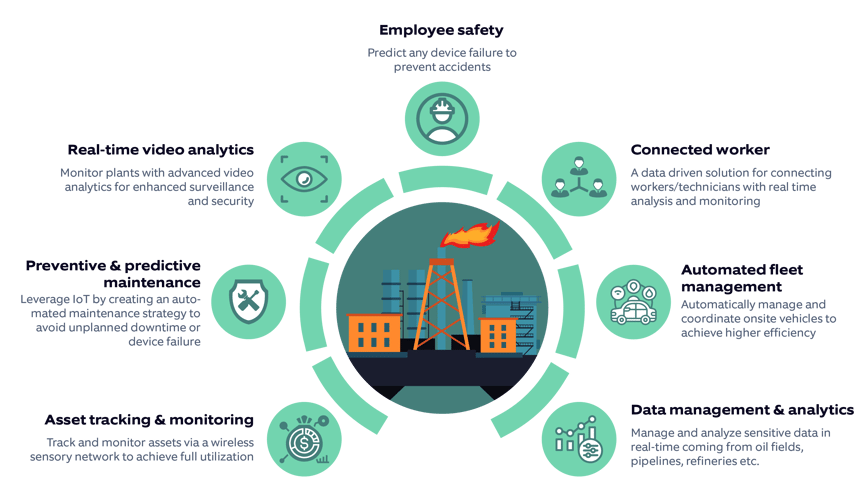 The Oil and Gas (O&G) industry is currently undergoing a transition as the world desires to move towards clean-renewable energy, coupled with the uncertainty around global demand. Eventually, this will force organizations to reduce their operational & capital expenditure. Over the years, the oil and gas industry has relied heavily on its own telecommunication network. The communications with vessels or sites are made via satellite links that are expensive and difficult to manage remotely. Often, operational complicacies arise due to high data latency, which can have a high impact on an O&G plant.
The Oil and Gas (O&G) industry is currently undergoing a transition as the world desires to move towards clean-renewable energy, coupled with the uncertainty around global demand. Eventually, this will force organizations to reduce their operational & capital expenditure. Over the years, the oil and gas industry has relied heavily on its own telecommunication network. The communications with vessels or sites are made via satellite links that are expensive and difficult to manage remotely. Often, operational complicacies arise due to high data latency, which can have a high impact on an O&G plant.
 Key challenges for the oil and gas industry
Key challenges for the oil and gas industry
Oil and gas companies need to adapt quickly to stay relevant—which is why, identifying and investing in innovative business models is the way forward for them. The global market trends indicate that O&G operations are increasingly moving towards remote and unfavorable geographical locations.
In operational terms, reliability and stability continue to be the top priorities for any oil and gas company. Various field telecommunication channels such as Virtual Fiber, 4G/LTE, O3b satellite constellations, etc. have enabled companies to transport high volume data. Technologies like AI/ML and edge computing can be leveraged to perform real-time analysis on this data. Contrary to the traditional approach (where data is sent to a distant server for analysis), O&G operations are now managed by bringing data closer to the field operator.
The industry-wide disruption due to COVID-19 has created a few more headaches for the oil and gas sector, such as:
- a sharp decline in fuel demand
- uncertainty around cost structure during the pandemic
While recovering upto the pre-COVID times will happen at its own pace, the pandemic has prompted firms to re-think their digital strategies. Other industries have been quite swift in exploring digital technologies. On the other hand, the oil and gas industry has started realizing the benefits and is keen on leveraging them for their needs. This is further proven by a study which concludes that O&G companies can reduce their capital expenditure by 20% by adopting digital technologies. As per a Strategy& report, 70 percent of the surveyed 200 O&G companies are in their initial phases of digital adoption. One such technology that can be a critical enabler for oil and gas firms during their migration from industry 3.0 to industry 4.0 is edge computing. Interestingly, telcos will have a crucial role in ensuring its adoption.
With recent developments in communication technologies, network operators can cater to the industry’s requirements in a cost-effective manner without compromising on performance or reliability.
Edge computing and private networks
In simple words, edge computing means that centralized applications run at the edge of the network or on devices to reduce latency and achieve high performance for data communication. It attempts to perform computation close to the data source, i.e., sensors, SCADA, surface & sub-surface facilities, etc. The typical operations in an oil and gas sector, irrespective of scale, can essentially be summed by the need to deliver relevant data to processes like exploration, production, and downstream. The relevant data must be processed through a low-latency framework so that business decisions can be taken in real-time.
Edge computing has been instrumental in the growth of several industries like manufacturing, automotive, sports & entertainment, healthcare, etc. There is a lot of scope for cloud adoption in the typical operations of the O&G industry. The industry has for long been producing huge amounts of data and analyzing them to make business decisions. This trend of generating high volumes of data is likely to continue. It is quite clear that a smarter and faster way to analyze data and extract useful insights out of it is the need of the hour. This has now been made possible with the help of sensors that collect and transmit real-time production data.
Contrary to how things were done previously, edge computing can be leveraged to process production data in real-time and make business decisions. Essentially, this means that the over-reliance on satellite links to transmit data can be reduced and replaced with technologies where the data transfer from oil rigs to data centers is quicker. Field telecommunication technologies have enabled companies to implement their remote field assessment and management activities.
Edge computing can help achieve operational intelligence by connecting isolated environments like production wells, pipelines, offshore rigs, vessels, etc. with smart solutions.
Low-cost sensors and computational ability have ensured that components or processes can be monitored in a much cheaper way. For mission-critical operations, only the relevant data can be analyzed to act in real-time. Be it predictive maintenance, automated guided vehicles, augmented reality for workers, or smart grids, there are several use-cases that the industry can benefit from by adopting edge computing. It is also important for oil and gas companies to host these sensors and devices on a private network. This provides numerous benefits such as scalability, performance, cost, and most importantly, security. The recent auction for CBRS spectrum in the United States has led to the democratization of the wireless spectrum. Organizations that own a license can now set up their own private network and can host any number of devices and sensors as per their requirements.
Legacy assets like analog meters and gauges, motors, valves, gears, etc. can be digitized by sensors and low-latency networks for real-time data processing.
Some relevant use cases for the oil and gas industry
The upstream activities are often carried out in unfavorable work locations, and connectivity is just one aspect of the set of challenges in remote places. Besides safety risks and the unpredictability of harsh environments, there is a lot more that a drilling team needs to check. An edge setup can resolve some of these headaches. For instance, imagine an employee safety scenario where all employees are equipped with wearables that monitor real-time biometric information like heart rate, brain activity or blood oxygen levels. This information is continuously transmitted via intelligent sensors over a secure private wireless network. By leveraging advanced analytics techniques, informed decisions on employee safety can be taken pre-emptively to avoid any unforeseen situation. Minimizing on-site risks is one of the many benefits of digitization that the oil and gas industry can reap.
According to a Cisco report, a typical offshore operation generates around 1-2 TB of data daily and it is estimated that with a satellite connection, it would take around 12 days to transfer just one day’s data.
Edge devices and IoT can also address some of the challenges of the midstream sector, related to crude oil storage and transportation. For example, plant machinery connected via sensors streams data to edge devices hosted on a secure private network. This data is analyzed by AI/ML algorithms to predict and identify the deviations in equipment performance. Intelligent AI/ML models hosted on an edge server help extract, classify, analyze, and process data in real-time. A timely alert on an impending equipment failure helps plan the repair process efficiently, thereby avoiding machine downtime. Such predictive maintenance solutions can help organizations save millions of dollars in lost productivity and repairs. Industry leaders like Schlumberger and Shell are already utilizing the power of edge computing for their worker safety and productivity use cases. 
Use cases for the oil and gas industry
Role of telcos in this journey
In the context of a private network for enterprises, telecom companies play a major role in establishing dedicated mobile network infrastructures. With their rich experience in the deployment and operations, telcos can build a robust dedicated on-site mobile network. Spectrum licenses would enable such a network to run under a managed SLA contract. Apart from these, telcos can also offer enterprises with other deployment strategies like network slicing and partner network.
Reports suggest that telcos are experiencing a decline in their core business. With the advent of 5G and its increasing usage across industries, telcos should leverage this to explore new sources of revenue growth. One such area to explore would be 5G private network and edge computing, where B2B offerings can be provided to enterprises with tailored solutions, addressing the industry-specific use cases. It is worth mentioning that the challenges for telcos in setting up a private network infrastructure, aerial deployment to radio backhaul network, and integrating the IT solutions are quite cumbersome. Telcos can collaborate with solution partners to host these software solutions on edge networks in a cost-effective agreement. Such a model would generate monetization opportunities for both the stakeholders.
 Telcos monetizing edge
Telcos monetizing edge
How can Nagarro help?
It is quite evident that edge computing could potentially help telcos move up the value chain by strategically providing B2B services to their existing clientele. Being an end-to-end provider for network requirements and IT solutions would attract newer customers as well. A synergistic engagement with partners can help them accelerate development and reduce the time-to-market. In this ever-evolving space, telcos should strategize to utilize edge capabilities efficiently.
Nagarro, with its dedicated Centers of Excellence and expertise in these competence areas, can be your ideal partner in this journey. We pride ourselves in helping our clients with their edge computing needs. Some of our solutions include:
- An AI-powered employee safety solution for a global OEM
- A machine vision solution for a leading package management & locker solutions company
- A video analytics solution for audience engagement for a US based telecom giant
Do you want to know more about our ‘edge-compatible’ smart solutions that can be tailored as per your business requirements? To know and discuss more about such solutions for your business, feel free to explore our offerings and reach out to us.





